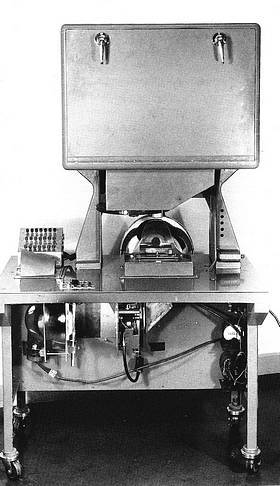| Kodak Colour Printer, Type S.1 |
|
|
|
|
|
Paul Godfrey is presently building a web site about the photofinishers that operated around Great Yarmouth in the 1960s & 70s and the equipment they used. Paul also has another small web site giving information about Harold White, who lived his latter days in the Great Yarmouth area but was a top photographer in the 1930s, 40s & 50s. He was also a historian and biographer to William Henry Fox Talbot. Paul sent the following information, drawn from the book by Jack Coote (see the Ilford Chronology, 1952 entry) in his 1970 “Photofinishing Techniques” book. |
||
 The Kodak S.1 as advertised by Kodak in the British Journal Photographic Almanac in 1960 |
Initially, Eastman Kodak in the US had processed and printed Kodacolor negatives using a very complex printer called a 1599. This was an 'additive printer' which used separate exposures of red, green and blue light. Because of reciprocity problems with the multilayer printing paper, the exposures were all of the same duration and it was the intensity of the light through each filter which was varied. They then brought out the Type IVC printer. This was made available to photo' finishers in the US and again this was an additive printer but this time it was the timings of the red, green and blue exposures which were varied rather than the intensity of the light source. In Britain, when Kodak began to sell Kodacolor film to amateurs in 1957, the films were at first processed and printed by Kodak themselves and for printing they used some Type IVC printers imported from the US, but quickly converted to the use of the British designed and made S.1 subtractive printer. The S.1 was the printer that Kodak Limited offered to the independent finishers in Britain when in 1958 Kodacolor processing was freed from restriction. |
|
|
The Kodak S.4 and S.4P printers followed the S.1 in Britain, while Eastman Kodak made the 5.S in the USA. All of these were white-light printers using subtractive termination. Right is shown the Colour Printing Room in mid-1964 at Hamilton Tait Ltd Colour Processing Laboratory at Penicuik, Midlothian. It consisted of five Kodak S.1 printers and a Kodak 5.S2. |
 |
|
 Kodak S.1 as shown in History of Colour Photography, by Jack Coote. |
Jack Coote continues in another chapter in the same book describing the subtractive (white light) method of printing used by the Kodak S.1. The first subtractive printer to be used commercially was the Kodak S.1 designed by Dr Robert W.G. Hunt of Kodak Research Laboratories at Harrow in England. The S.1 printer was used by Kodak in 1957 and made available to British photofinishers in 1958. In the S.1 printer, exposure commences with unfiltered light from an incandescent source which allows all three red, green and blue exposures to proceed at the same time. The predetermined amounts of each of the component exposures are obtained by automatic insertion of subtractive filters at the appropriate times. In other words, when the required amount of red light has reached the print material a cyan (minus red) filter is inserted into the exposing beam so that only green and blue light continues to reach the printing plane. When the green exposure is sufficient then a magenta (minus green) filter is inserted into the beam as well. Similarly, when the channel monitoring blue light has been satisfied, a yellow (minus blue) filter is used to terminate the blue exposure. The filters are controlled by photo-cells which analyse and measure the integrated light coming through the colour negative. In principle, nearly all modern integrating colour printers now operate in this way. The illustration of a S.1 shown to the left appears in Jack Coote's book "History of Colour Photography" (foreword by Dr Robert Hunt of Kodak Research). Paul Godfrey points out that these pictures (above and left) have detail differences. "I guess this is because Jack Coote shows a pre-production prototype. Notice there are no covers on the lamphouse and the controls on the left are in a different place. The BJPA image also has Kodak badges. Both pictures show the ellipsoid reflector on top of the negative carrier that collected the light for the photo cells." |
|
| Paul Godfrey closed
by saying: "I have not operated an S.1 but saw them in use in the early 1970s at Riverside Colour Labs in Gorleston, Norfolk. Riverside was owned by John Chown. John had bought one of his two S.1s from Eddie Brewster who owned East Anglian Colour Laboratories in Caister-on-Sea, Norfolk. Eddie was the first person to offer a colour D&P service in the Great Yarmouth area. I believe he started processing Kodacolor from around 1960. I have a large plastic spiral that came from East Anglian Colour Labs and believe it was used to process cut lengths of exposed 3½” Kodak colour paper in standard 3 gallon Kodak tanks". |
||
|
Chris McLennan has e-mailed (June 2010) to say: I then worked for Wrates at Skegness. They had many Kodak S3 printers. Most of these were upgraded from the original Kodak specification. These printers had sliding glass subtractive filters controlled by two dials; the operator rotated the two dials to match two needles on a meter to correct the colour balance and then pressed the 'PRINT' button. |
||
|
|
|
|
|
|
||